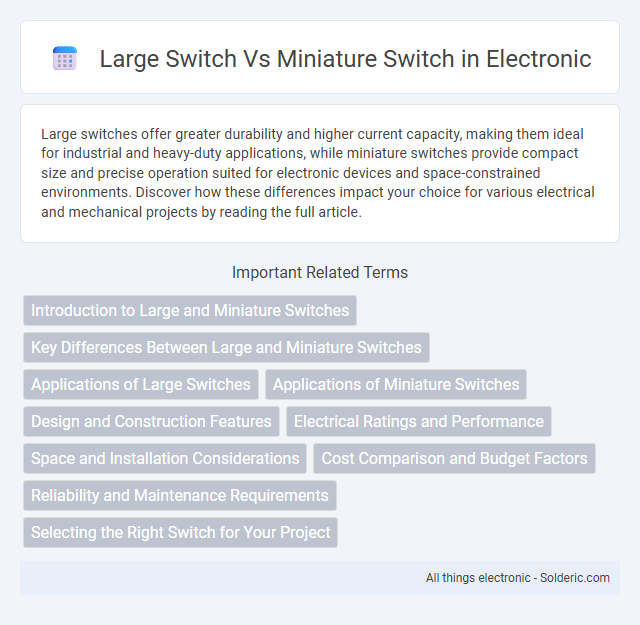Large switches offer greater durability and higher current capacity, making them ideal for industrial and heavy-duty applications, while miniature switches provide compact size and precise operation suited for electronic devices and space-constrained environments. Discover how these differences impact your choice for various electrical and mechanical projects by reading the full article.
Comparison Table
| Feature | Large Switch | Miniature Switch |
|---|---|---|
| Size | Typically over 8 inches in width | Typically under 8 inches in width |
| Port Density | Lower port density | Higher port density |
| Power Consumption | Higher power usage due to larger capacity | Lower power usage, energy efficient |
| Use Case | Core networks, data centers requiring high throughput | Access layer, small to medium networks |
| Cost | Higher upfront and operational cost | Lower cost, budget-friendly |
| Scalability | Highly scalable with modular design | Limited scalability, fixed configuration |
| Management | Advanced management features | Basic to moderate management features |
Introduction to Large and Miniature Switches
Large switches are industrial-grade components designed for high current and heavy-duty applications, commonly used in machinery and power distribution. Miniature switches are compact, designed for low current applications in electronic devices, offering precision control in limited spaces. Both types serve crucial roles in electrical systems, balancing size and capacity according to operational needs.
Key Differences Between Large and Miniature Switches
Large switches are designed for high current and voltage applications, offering greater durability and mechanical strength compared to miniature switches. Miniature switches are compact, ideal for low power circuits and precise control in limited spaces, providing rapid response with lower actuation force. Your choice depends on the specific electrical requirements and space constraints of your project.
Applications of Large Switches
Large switches are extensively used in industrial environments, data centers, and telecommunications infrastructure where high-capacity and high-reliability switching is essential. These switches handle substantial electrical loads and are key components in power distribution systems, motor control panels, and large-scale automation setups. Their robust design supports heavy-duty applications, ensuring durability and safety under demanding operating conditions.
Applications of Miniature Switches
Miniature switches are commonly used in precision electronic devices, medical instruments, and compact consumer electronics where space constraints demand smaller components. Their applications include controlling circuit operations in automotive systems, home appliances, and telecommunications equipment. The small size and reliable performance of miniature switches make them ideal for environments requiring frequent actuation and high durability.
Design and Construction Features
Large switches typically feature robust construction with metal or heavy-duty plastic housings designed to handle higher electrical loads and provide durability in industrial environments. Miniature switches are compact, often encased in lightweight plastic with smaller contact gaps, optimized for low-power circuits and limited space applications. The design of large switches includes larger terminals and actuators for easy manual operation, whereas miniature switches prioritize compactness and integration within electronic devices.
Electrical Ratings and Performance
Large switches typically offer higher electrical ratings, supporting currents up to several hundred amperes and voltages exceeding 600V, making them suitable for heavy-duty industrial applications. Miniature switches are designed for lower electrical loads, generally handling currents below 10 amperes and voltages under 250V, providing precise control in compact electronic devices. Understanding these performance differences ensures you select the appropriate switch for your electrical requirements, balancing capacity with size and functionality.
Space and Installation Considerations
Large switches require significantly more space due to their bulkier design, making them less suitable for compact installations where space optimization is critical. Miniature switches, with their compact size, offer greater flexibility and ease of installation in tight or densely packed environments. Choosing miniature switches can reduce overall panel size and wiring complexity, streamlining the installation process in modern electronic systems.
Cost Comparison and Budget Factors
Large switches typically involve higher upfront costs due to greater capacity and advanced features, making them more suitable for enterprise networks with extensive infrastructure needs. Miniature switches offer a budget-friendly alternative with lower purchase and operational expenses, ideal for small to medium-sized setups or limited-space environments. When planning Your network budget, consider the total cost of ownership, including installation, maintenance, and scalability requirements.
Reliability and Maintenance Requirements
Large switches generally offer higher reliability due to their robust construction and ability to handle heavier electrical loads, reducing the frequency of failures in demanding applications. Miniature switches, while compact and suitable for space-constrained environments, often require more frequent maintenance to address wear from lower durability components and higher susceptibility to contact degradation. Your choice between large and miniature switches should consider the maintenance resources available and the importance of long-term operational reliability in your system.
Selecting the Right Switch for Your Project
Selecting the right switch for your project depends on space requirements, electrical ratings, and application demands. Large switches offer higher current capacity and durability, ideal for heavy-duty or industrial use, while miniature switches provide compact size and precise control suited for compact electronics and low-power circuits. Evaluating load capacity, actuator sensitivity, and mounting options ensures optimal performance and reliability.
Large switch vs Miniature switch Infographic

 solderic.com
solderic.com